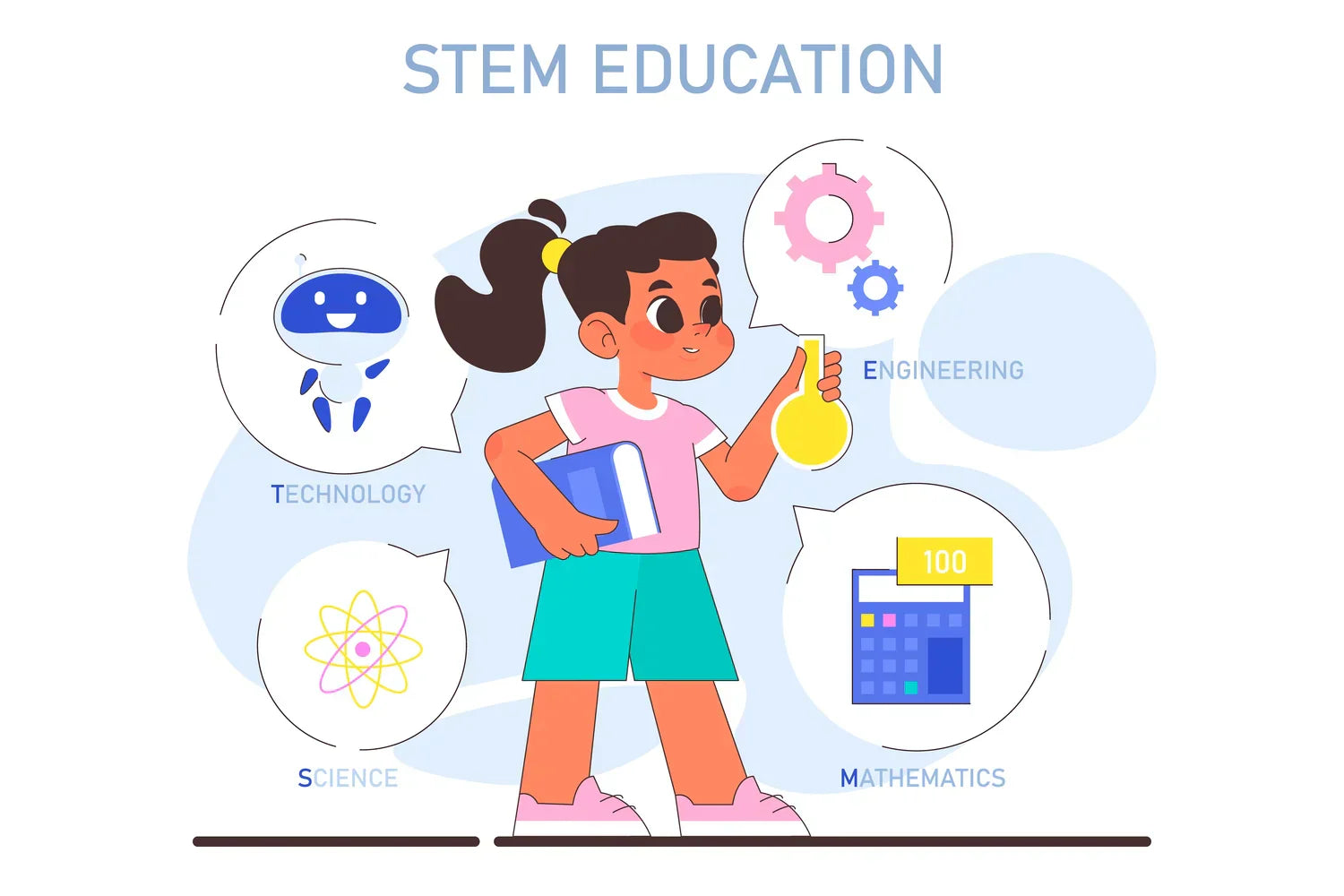With improving technological advancements, the importance of STEM education has grown significantly, equipping learners with the skills needed for high-demand careers. If you’ve been hearing the term STEM education but are unsure about what it means and why it’s important, you’re in the right place! STEM, which stands for Science, Technology, Engineering, and Mathematics, is not merely a list of subjects—it's an active learning methodology that equips students for the future. In this article, we will provide you with a comprehensive overview of STEM education, its importance, advantages, career prospects, and practical applications.
What is STEM Education?
STEM education, an acronym for Science, Technology, Engineering, and Mathematics, is an interdisciplinary paradigm that converges these four fields under one learning framework. STEM education emphasizes not only theoretical learning but also practical application, which prepares learners to solve real problems in real life. This mode of learning promotes critical thinking, problem-solving, and collaboration, which are requisite in this rapidly changing era of high technology.
Meaning of STEM Education
In simple terms STEM education full form is Science, Technology, Engineering, and Mathematics . Understanding the meaning of STEM education involves recognizing its role in bridging traditional academic boundaries. By combining science, technology, engineering, and mathematics, STEM education encourages students to explore connections between subjects, leading to a more comprehensive understanding of complex concepts.
The importance of STEM education system cannot be overstated. It equips students with the skills necessary to excel in various industries, driving innovation and economic growth. According to TechTarget, STEM programs aim to foster inquiring minds, logical reasoning, and collaboration skills, which are crucial for addressing societal challenges and maintaining global competitiveness.
Why is STEM Education Important?
The world is advancing technologically, and STEM education ensures that students remain prepared for future challenges. What is STEM education, and why is it important? It is crucial because it enhances analytical skills, encourages creativity, and prepares students for careers that demand expertise in science and technology. A strong foundation in STEM subjects opens doors to numerous career opportunities, ranging from engineering and information technology to healthcare and research.
STEM Education Curriculum
The STEM education syllabus is interactive and dynamic, with hands-on projects and practical problem-solving exercises. For instance of STEM education, students would engage in robotics competitions, coding boot camps, or environmental science projects. All these experiences reinforce theoretical concepts while showcasing the practical implementations of STEM techniques.
Such experiential learning platforms are critical in maintaining student enthusiasm and inducing a lifelong love for these subjects.
Examples of STEM Education
STEM education integrates Science, Technology, Engineering, and Mathematics education into real-world learning experiences. Here are some practical examples of STEM education in action:
-
Robotics and Coding Programs – Schools introduce students to coding and robotics, allowing them to build and program robots for various tasks.3D Printing Projects – Students create and 3D print models to learn engineering principles and problem-solving methods.
-
Science Experiments – Hands-on experiments such as conducting chemical reactions, observing plant growth, or constructing electrical circuits improve scientific inquiry.
-
Mathematical Modeling – Using real-world data to create mathematical models for financial planning, weather predictions, or sports analytics.
-
Engineering Challenges – Activities like bridge-building, roller coaster design, or earthquake-resistant structures teach physics and engineering principles.
-
Virtual Reality (VR) Learning –Utilizing VR simulations for medical training, space exploration, or historical reenactments to improve interactive learning.
-
STEM-based Competitions – Events like science fairs, coding hackathons, and engineering design challenges promote critical thinking and innovation.
-
Environmental Science Projects – Activities such as water filtration experiments, renewable energy projects, and climate change studies engage students in sustainability topics.
-
Medical Research Simulations – High school and college students engage in DNA sequencing, microbiology studies, and drug development projects to understand biomedical sciences.
- Game Development and Animation – Learning programming languages like Python and Java to create video games, animations, or mobile apps.
Benefits of STEM Education
The benefits of STEM education extend beyond academic achievement. It promotes creativity, resilience, and adaptability—traits essential for success in any endeavor. Engaging with STEM education resources, such as interactive simulations, laboratory experiments, and collaborative projects, enables students to develop a deeper understanding of the material and its relevance to real-world situations.
Furthermore, exposure to STEM education courses can inspire students to pursue advanced studies and careers in these fields, contributing to a skilled and innovative workforce. By focusing on experiential learning, students gain hands-on experience that enhances their problem-solving abilities and critical thinking skills.
Explore These Topics:
Careers in STEM Education
There are various STEM education jobs that are highly sought after. Individuals with a STEM background are in high demand in fields such as technology, engineering, medicine, and environmental science. These roles often offer competitive salaries and opportunities for advancement. By investing in STEM education, individuals position themselves at the forefront of innovation and industry leadership.
According to Britannica, science, technology, engineering, and mathematics education plays a critical role in developing a workforce capable of driving technological progress and addressing complex global issues. This means that STEM graduates are essential in solving pressing challenges in fields such as artificial intelligence, medical research, space exploration, and sustainable energy.
Here’s a list of some of the most sought-after careers after completing STEM courses:
- Software Engineer
Software engineers design, develop, and implement software for different platforms. As the digital world continues to grow, software engineering is still one of the most sought-after career paths. Software engineers construct applications, administer databases, and provide smooth user experiences in the virtual world.
- Cloud Architect
Cloud architects develop and operate cloud technology solutions. They coordinate cloud computing initiatives to promote scalability, security, and efficiency in cloud systems. With companies moving more into cloud technologies, expert cloud architects remain high in demand.
- Web Developer
In the digital age, having an online presence is essential for businesses. Web developers work on both the front-end (user interface) and back-end (server-side functionality) of websites, ensuring a seamless experience for users. Proficiency in coding languages such as HTML, CSS, JavaScript, and Python is crucial for this role.
- IT Manager
IT managers oversee an organization’s technology infrastructure. They ensure the smooth operation of IT systems, manage cybersecurity measures, and lead tech teams to support business operations. This role requires a strong foundation in information technology and leadership skills.
- Astronomer
Astronomers research celestial bodies, space phenomena, and the structure of the universe. The profession demands knowledge in astrophysics, calculus, and observation skills. Astronomers may be employed in research centers, space organizations, and academies
- Electrical Engineer
Electrical engineers design and construct electrical systems, ranging from household devices to electricity grids. They are pivotal in the design of renewable sources of energy, such as wind and solar power. This occupation contributes to driving energy efficiency and sustainability.
- Geologist
Geologists investigate the composition, structure, and processes of the Earth. Their expertise is necessary in mining, resource exploitation, and environmental preservation industries. Geologists also play a role in urban planning and disaster management.
- Mechanical Engineer
Mechanical engineers research, design, and develop mechanical systems, including engines, robotics, and industrial machinery. With automation and technological advancements, mechanical engineers play a vital role in improving production efficiency and innovation.
- Actuary
Actuaries use mathematical, statistical, and financial theory to examine financial risk. Actuaries are employed in the fields of insurance, banking, and investment companies. As companies always evaluate financial risk, actuaries continue to be integral in making economic choices
- Doctor
STEM education provides the foundation for medical careers. Doctors diagnose and treat illnesses, perform surgeries, and research medical advancements. A strong understanding of biology, chemistry, and physics is essential for medical professionals.
- Scientist
Scientists conduct research in various fields, from biotechnology to space exploration. They contribute to medical breakthroughs, technological innovations, and environmental solutions. STEM education fosters critical thinking and problem-solving skills, enabling scientists to drive progress in their respective fields.
You may also like reading:
-
TOEFL Accepting Countries and Universities
-
PTE Accepting Countries and Universities
- GRE Accepting Countries & Universities
Where Did STEM Education Come From?
The history of STEM education dates back to attempts in the early 2000s to address competitiveness in science and technology. Schools saw the necessity of a curriculum that accommodated the connected nature of these subjects, so they developed and implemented STEM-based programs. The purpose was to have graduates with diverse skills sets, capable of making meaningful contributions to a more complicated and technology-intensive world.
Conclusion
In summary, STEM education is an essential aspect of contemporary education, equipping students with the skills and exposure required to thrive in different lines of work. Its focus on interdisciplinarity, hands-on learning, and development of critical skills makes it imperative in shaping the future generation of innovators and problem-solvers. By understanding the STEM education full form and its real-world applications, students can embark on careers that drive technological advancements and global progress.
Complementary Read:
-
Best Consultant for Abroad Study in India
-
Best Countries to Study Abroad
- Top 10 Universities in the World
- Top 10 Most Toughest Exam in India
Frequently Asked Questions:
Q: What does STEM stand for?
A: STEM stands for Science, Technology, Engineering, and Mathematics.
Q: What are the core subjects included in STEM?
A: The core subjects in STEM include Physics, Chemistry, Biology, Computer Science, Engineering, and Mathematics.
Q: Why is STEM education important?
A: STEM education develops critical thinking, problem-solving, and innovation skills, preparing students for future careers in technology and science-driven industries.
Q: Who benefits from STEM education?
A: Students, educators, researchers, and industries benefit from STEM education as it fosters technological advancements and economic growth.
Q: What are some examples of STEM careers?
A: Examples of STEM careers include Software Engineer, Data Scientist, Mechanical Engineer, Doctor, Astronomer, and AI Specialist.
Also Read:
- Statement of Purpose
- Letter Of Recommendation
- How to Study Abroad
- Academic Transcripts
- Consolidated Marksheet
"Plan Your Study Abroad Journey with EduVouchers"
Getting into a top universities abroad requires more than just good grades. You need to take language proficiency exams like PTE, GRE, TOEFL, or DUOLINGO, which can be expensive and challenging to prepare for. That’s where EduVouchers comes in!
What We Offer:
-
Discount Vouchers: Get exclusive savings on exam fees for PTE, GRE, TOEFL, DUOLINGO, and more.
-
Free Exam Booking Assistance: We help you book your tests at no extra cost.
Check out: PTE Exam Booking, PTE Core Exam Booking.
-
Mock Tests & Study Resources: Access high-quality practice tests, guides, and preparation materials to boost your scores.
-
Expert Blogs & Insights: Stay informed with tips on exam strategies, university applications, scholarships, and visa processes.
Why Choose EduVouchers:
-
Affordable Preparation: Our discount vouchers and free resources help you save money while preparing for your exams.
-
Expert Support: From booking your exams to providing study materials, we’re here to support you every step of the way.
-
Proven Success: Thousands of students have trusted us to help them achieve their study abroad dreams.
If you’re planning to study abroad, don’t let exam costs or preparation hurdles slow you down. Visit EduVouchers today and start your journey with confidence and savings!












